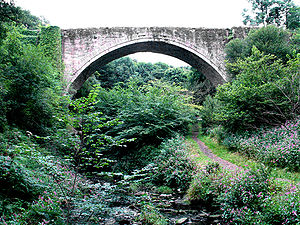
Causey Arch
Encyclopedia

Stanley, County Durham
Stanley is a former colliery town and civil parish in County Durham, England. Centred on a hilltop between Chester-le-Street and Consett, the town lies south west of Gateshead....
in County Durham
County Durham
County Durham is a ceremonial county and unitary district in north east England. The county town is Durham. The largest settlement in the ceremonial county is the town of Darlington...
. It is the world’s oldest surviving railway bridge.
It was built in 1725-26 by stonemason Ralph Wood, funded by a conglomeration of coal-owners known as the "'Grand Allies'" (founded by Colonel Liddell and the Hon. Charles Montague) at a cost of £12,000. Two tracks crossed the Arch: one (the main way) to take coal to the River Tyne, and the other (the bye way) for the returning the empty wagon
Wagon
A wagon is a heavy four-wheeled vehicle pulled by draught animals; it was formerly often called a wain, and if low and sideless may be called a dray, trolley or float....
s. Over nine hundred horse-drawn
Horse-drawn vehicle
A horse-drawn vehicle is a mechanized piece of equipment pulled by one horse or by a team of horses. These vehicles typically had two or four wheels and were used to carry passengers and/or a load...
wagons crossed the arch each day using the Tanfield Railway
Tanfield Railway
The Tanfield Railway is a standard gauge heritage railway in Gateshead and County Durham, England. Running on part of a former colliery wooden wagonway, later a steam railway, it operates preserved steam and diesel industrial tank locomotives. The railway operates a passenger service on Sundays all...
.
At the time the bridge was completed in 1726, it was the longest single span bridge in the country with an arch span of 31 m, a record it held for thirty years until 1756 when a bridge was built in Pontypridd
Pontypridd
Pontypridd is both a community and a principal town of Rhondda Cynon Taf, Wales and is situated 12 miles/19 km north of the Welsh capital city of Cardiff...
, Wales.
An inscription on a sundial
Sundial
A sundial is a device that measures time by the position of the Sun. In common designs such as the horizontal sundial, the sun casts a shadow from its style onto a surface marked with lines indicating the hours of the day. The style is the time-telling edge of the gnomon, often a thin rod or a...
at the site reads "Ra. Wood, mason, 1727".
Use of the Arch declined when Tanfield
Tanfield, Durham
Tanfield is a former mining village in County Durham, England near Stanley and is the location of Tanfield Railway and the Causey Arch. It is also the location of Tanfield School.-History:...
Colliery was destroyed by fire in 1739.
The Arch was restored and reinforced in the 1980s. There are a series of scenic public paths around the area and the Causey Burn
Burn (stream)
In Scotland, North East England and some parts of Ireland and New Zealand, burn is a name for watercourses from large streams to small rivers. The term is also used in lands settled by the Scots and Northern English in other countries, notably in Otago, New Zealand, where much of the naming was...
which runs underneath it. The quarry near the bridge is a popular spot for local rock climbers.
Causey Burn itself flows into Beamish Burn which then flows into the River Team
River Team
The River Team is a tributary of the River Tyne in Gateshead, England.Its source is near Annfield Plain, where it is known as Kyo Burn. Then changing its name again to Causey Burn as it flows underneath the famous Causey Arch. It then flows past Beamish Museum in County Durham then crosses the...
eventually discharging into the River Tyne
River Tyne
The River Tyne is a river in North East England in Great Britain. It is formed by the confluence of two rivers: the North Tyne and the South Tyne. These two rivers converge at Warden Rock near Hexham in Northumberland at a place dubbed 'The Meeting of the Waters'.The North Tyne rises on the...
.
Interesting facts
A local legend is that Wood, haunted by the collapse of his earlier timber bridge and fearing that this arch would also collapse, committed suicideSuicide
Suicide is the act of intentionally causing one's own death. Suicide is often committed out of despair or attributed to some underlying mental disorder, such as depression, bipolar disorder, schizophrenia, alcoholism, or drug abuse...
by jumping from the top of it. This is probably untrue. This information appears to be derived from a two-volume book called "Local Records" published in 1833 by John Sykes. Sykes was writing more than 100 years after the event and may be mistaken, or simply reporting local rumour. The origin of the suicide story remains obscure but contemporary accounts are strangely silent on the matter. Later texts (e.g. "Annals of Coal Mining and the Coal Trade" by Robert Galloway) also repeat the story. Websites like that of the Durham Mining Museum report these lurid tales apparently without checking them. Contemporary records clearly state that Wood was still employed by George Bowes
George Bowes
Sir George Bowes was an English Member of Parliament and coal proprietor.George Bowes was baptized on 4 September 1701, the youngest son of Sir William Bowes, MP, and Elizabeth Bowes...
some months after the opening, and according to Professor Skempton if Wood did throw himself off the Arch then he landed a long way away – he apparently died in Stockton-on-Tees in 1730 (Skempton, 2002). This intriguing tale thus remains to be confirmed. The explanation that Wood was distraught after seeing his first bridge collapse into the gorge is also problematic, as Wood was a mason – a worker in stone, the likelihood of him being involved with the first timber-built structure is doubtful seeing as Bowes employed numerous engineers precisely for such tasks!

